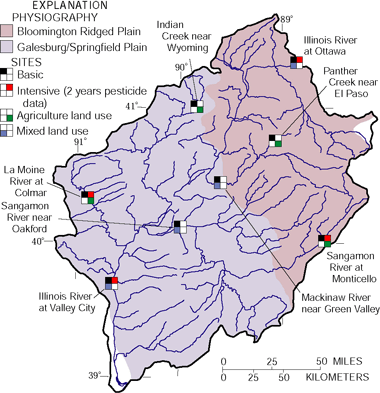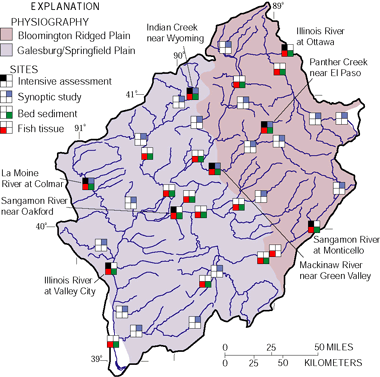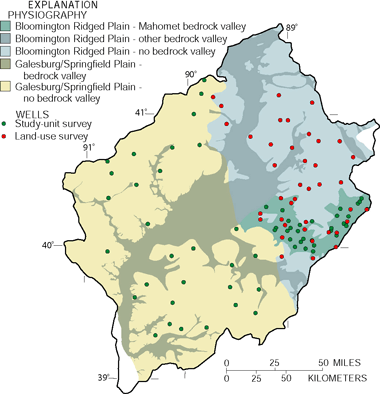STUDY UNIT DESIGN
| Stream Chemistry The main objective of the stream-chemistry component of the study was to assess the relation between agricultural land use and basin size and chemical constituents of surface water. Stream and river sampling locations were distributed among subbasins and on the Illinois River. Sampling locations included Basic and Intensive Fixed Sites—sampled at regular intervals for a period of 2 to 3 years—and Synoptic Sites that were sampled during a 2-week period in August 1997.
|
 |
 |
Stream Ecology The main objective of the ecology component of the study was to assess surface-water quality by integrating the physical, chemical, and biological factors. Ecology Sites were distributed at the basic fixed sites and at smaller subbasins that are all predominantly agricultural land. Sites were classified as either intensive or synoptic on the basis of the level and schedule of sampling effort.
|
| Ground-Water Chemistry One objective of the ground-water chemistry component of the study was to determine whether chemical constituents of ground water were related to agricultural land uses (land-use surveys). Another objective in two surveys of domestic (household) and public-supply (municipal) wells (Study-Unit surveys) was to assess the overall water quality in selected drinking-water-source aquifers (Mahomet aquifer and the western and southern shallow aquifers) and to determine whether they are affected by land-use practices. The full extent of the Mahomet aquifer (in the Mahomet bedrock valley) is not shown. Results for the Mahomet aquifer are representative only for that part shown. |
 |
| Study component |
What data were collected and why |
Types of sites sampled |
Number of sites |
Sampling frequency and period |
|---|---|---|---|---|
| Stream Chemistry |
||||
| Basic Sites--general water quality |
Concentrations, seasonal variation, and annual loads. Data included streamflow, nutrients, major ions, organic carbon, suspended sediment, water temperature, specific conductance, alkalinity, pH, and dissolved oxygen. |
Basic Fixed Sites: representative of common land uses, as well as major tributary and basin outflow sites. |
8 |
Monthly plus storms; |
| Intensive Sites--pesticides |
Concentrations and seasonal variations in pesticides and breakdown products. Data included 75 pesticides and 13 breakdown products of the most heavily applied herbicides. |
Subset of Basic Sites: Two watersheds with greater than 90 percent row-crop agriculture and the basin inflow and outflow sites. |
4 |
Weekly to monthly Jan. 1996-June 1998 |
| Synoptic Sites--water chemistry and pesticides |
Spatial distribution of nutrients, pesticides, and pesticide breakdown products. Data included nutrients and 24 pesticides and pesticide breakdown products. |
Basic Sites Additional sites |
4 17 |
Once in August 1997 during minimum flow |
| Contaminants in bed sediments |
Occurrence and distribution of contaminants in bed sediment. Data included total PCBs, 32 organochlorine pesticides, 63 semivolatile organic compounds, and 44 trace elements. |
Depositional zones of Basic Fixed Sites and some additional sites. |
21 |
Once; June-October in 1996-97 |
| Contaminants in fish |
Occurrence and distribution of contaminants in biota. Data included total PCBs, 30 organochlorine pesticides in whole fish, and trace elements in fish livers. |
Most stream sites also sampled for bed sediments. |
20 |
Once; June-October in 1996-97
|
| Stream Ecology |
||||
| Intensive assessments |
Relations among biological communities and water chemistry, physical habitat, and land use. Includes spatial relations, along with spatial variation. Data included algae, invertebrates, fish communities, and physical habitat. |
Basic Fixed Sites |
8 |
1
reach, 1 year (1996) |
| Synoptic studies |
Better spatial assessment. Data collected were same as above. |
Synoptic Sites |
21 |
Once in August 1997 |
| Ground-Water Chemistry |
||||
| Aquifer survey--domestic and public-supply wells |
Occurrence and distribution of chemicals in domestic and public-supply wells. Data included major ions, nutrients, 75 pesticides,13 pesticide breakdown products, 73 volatile organic compounds, dissolved organic carbon, trace elements, and radon. |
Domestic and public supply wells across the subunit aquifers |
2 public- |
Once; May-November in 1996-97 |
| Resample selected aquifer survey wells |
Confirmation of low-level or questionable detections of pesticides, breakdown products, and age-dating chemicals. |
A subset of the wells above |
19 |
Once in 1998 |
| Resample selected aquifer survey wells |
Confirmation of high-level detections of arsenic and to determine the chemical nature of the dissolved arsenic. Data included major ions and selected dissolved metals in addition to two chemical forms of arsenic. |
A subset of wells from the deep aquifer survey with arsenic that exceeded the drinking-water standard. |
10 |
Once in 1997 |
| Land-use effects--corn and soybean row crops |
Describe the effects of agricultural land use on shallow ground water in the area underlain by most recent glacial geologic material. Data included major ions, nutrients, 75 pesticides, 13 pesticide breakdown products, dissolved organic carbon, trace elements, and radon. |
Very shallow monitoring wells installed for this study. |
57 |
Once in 1997
|
| Table of Contents || Previous Section || Next Section || Glossary U.S. Geological Survey Circular 1209 Suggested citation:
|

